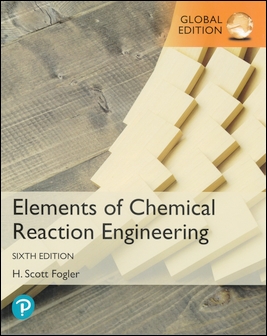Elements of Chemical Reaction Engineering 6/e
作者:H. Scott Fogler
原價:NT$ 1,480
內容介紹
本書特色
目錄
Description
Fordecades, H. Scott Foglers Elements of Chemical Reaction Engineering hasbeen the worlds dominant chemical reaction engineering text. Usingsliders and interactive examples in Wolfram, Python, POLYMATH, and MATLAB,students can explore reactions and reactors by running realistic simulationexperiments.
Writing for todays students, Fogler provides instant access to information,avoids extraneous details, and presents novel problems linking theory topractice. Faculty can flexibly define their courses, drawing on updatedchapters, problems, and extensive Professional Reference Shelf web content atdiverse levels of difficulty.
The book thoroughly prepares undergraduates to apply chemical reaction kineticsand physics to the design of chemical reactors. And four advanced chaptersaddress graduate-level topics, including effectiveness factors. To support thefields growing emphasis on chemical reactor safety, each chapter now ends witha practical safety lesson.
-
Updates throughout the book reflect current theory and practice and emphasize safety
-
New discussions of molecular simulations and stochastic modeling
-
Increased emphasis on alternative energy sources such as solar and biofuels
-
Thorough reworking of three chapters on heat effects
-
Full chapters on nonideal reactors, diffusion limitations, and residence time distribution
分類位置:
理工 > 化學/化學工程 > 化學工程
Features
-
Successfully integrates text, visuals, and computer simulations to help both undergraduate and graduate students master the fundamentals of chemical reaction engineering
-
Contains new examples, problems, and video instruction helping students to explore key issues, seek optimum solutions, and practice critical thinking and creative problem-solving
-
Presents expanded coverage of crucial safety topics to address the latest ABET requirements
-
Includes expanded coverage of bioreactions and industrial chemistry, introduced with real reactors and reactions
-
Ancillaryresources such as the solutions manual are available for faculty andinstructors
New to This Edition
In Elementsof Chemical Reaction Engineering, Sixth Edition, H. Scott Fogler hasmade numerous updates, including greater emphasis on Chemical Reactor Safety, anew discussion on molecular simulations and stochastic modeling in Chapter 3,interactive modules on Living Example Problems and Molecular Simulations,revision and reworking of Chapters 11-13 from the Fifth Edition, andmore. Wolfram and Polymath will be used to solve real-world chemicalreaction engineering problems and to explore how the reaction behaves as onemanipulates the system variables.
Forthe Sixth Edition, Fogler has made major changes to the website (http://www.umich.edu/~elements/5e)to more easily and readily facilitate Inquiry Based Learning (IBL). The websitewill feature greatly enhanced problems and examples through interaction exercises.Online ancillaries such as the Solutions Manual and PowerPoint Slides will beavailable for all instructors through the Pearson Instructor ResourceCenter.
ProfessionalFeature
The eagerlyanticipated new 6th Edition of the best-selling chemical reaction engineeringfor 30 years
-
Successfully integrates text, visuals, and computer simulations to help both undergraduate and graduate students master the fundamentals of chemical reaction engineering
-
Contains new examples, problems, and video instruction helping students to explore key issues, seek optimum solutions, and practice critical thinking and creative problem-solving
-
Presents expanded coverage of crucial safety topics to address the latest ABET requirements
Table of contents
Chapter 1: Mole Balances
Chapter 2: Conversion and Reactor Sizing
Chapter 3: Rate Laws
Chapter 4: Stoichiometry
Chapter 5: Isothermal Reactor Design: Conversion
Chapter 6: Isothermal Reactor Design: Moles and MolarFlow Rates
Chapter 7: Collection and Analysis of Rate Data
Chapter 8: Multiple Reactions
Chapter 9: Reaction Mechanisms, Pathways,Bioreactions, and Bioreactors
Chapter 10: Catalysis and Catalytic Reactors
Chapter 11: Nonisothermal Reactor Design: TheSteady-State Energy Balance and Adiabatic PFR Applications
Chapter 12: Steady-State Nonisothermal Reactor Design:Flow Reactors with Heat Exchange
Chapter 13: Unsteady-State Nonisothermal ReactorDesign
Chapter 14: Mass Transfer Limitations in Reacting Systems
Chapter 15: Diffusion and Reaction
Chapter 16: Residence Time Distributions of ChemicalReactors
Chapter 17: Predicting Conversion Directly from theResidence Time Distribution
Chapter 18: Models for Nonideal Reactors
上一則
|
回上頁
|
下一則



